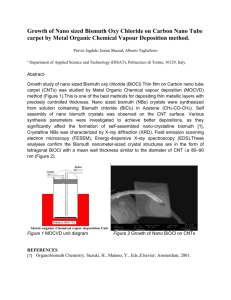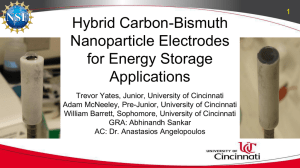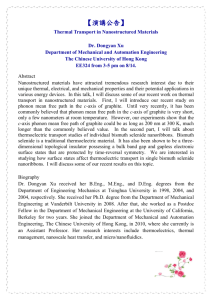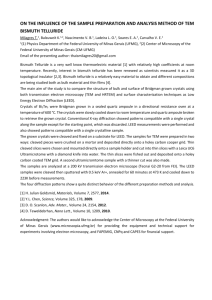Liquid-liquid extraction and recovery of bismuth(III) from hydrochloric
advertisement
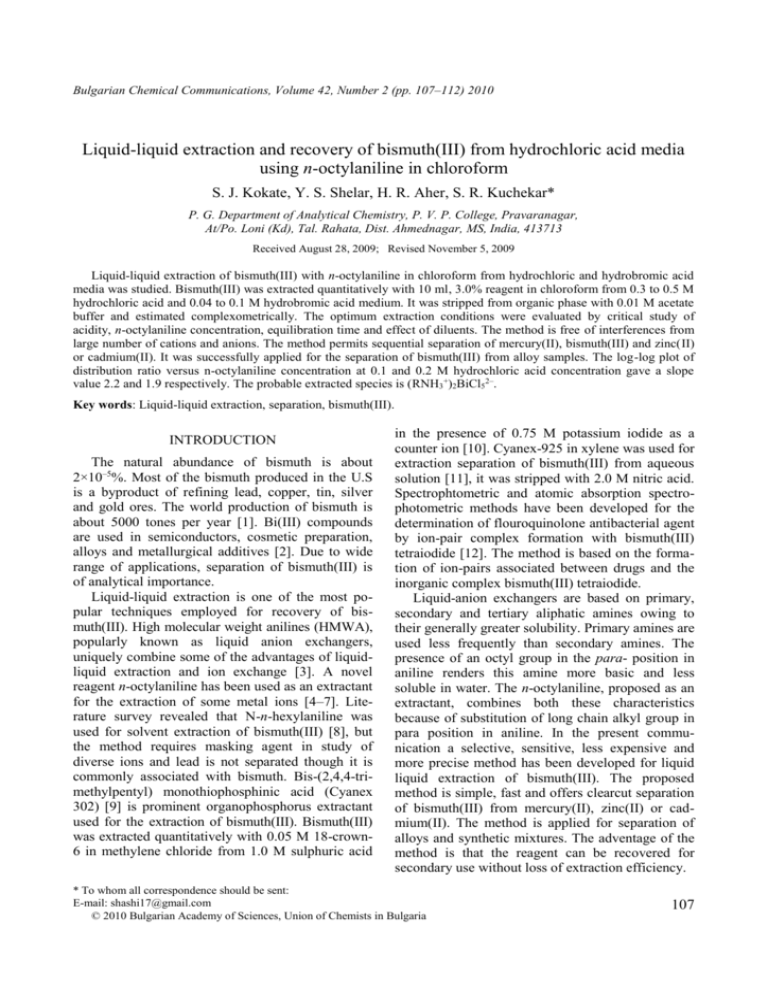
Bulgarian Chemical Communications, Volume 42, Number 2 (pp. 107–112) 2010 Liquid-liquid extraction and recovery of bismuth(III) from hydrochloric acid media using n-octylaniline in chloroform S. J. Kokate, Y. S. Shelar, H. R. Aher, S. R. Kuchekar* P. G. Department of Analytical Chemistry, P. V. P. College, Pravaranagar, At/Po. Loni (Kd), Tal. Rahata, Dist. Ahmednagar, MS, India, 413713 Received August 28, 2009; Revised November 5, 2009 Liquid-liquid extraction of bismuth(III) with n-octylaniline in chloroform from hydrochloric and hydrobromic acid media was studied. Bismuth(III) was extracted quantitatively with 10 ml, 3.0% reagent in chloroform from 0.3 to 0.5 M hydrochloric acid and 0.04 to 0.1 M hydrobromic acid medium. It was stripped from organic phase with 0.01 M acetate buffer and estimated complexometrically. The optimum extraction conditions were evaluated by critical study of acidity, n-octylaniline concentration, equilibration time and effect of diluents. The method is free of interferences from large number of cations and anions. The method permits sequential separation of mercury(II), bismuth(III) and zinc(II) or cadmium(II). It was successfully applied for the separation of bismuth(III) from alloy samples. The log-log plot of distribution ratio versus n-octylaniline concentration at 0.1 and 0.2 M hydrochloric acid concentration gave a slope value 2.2 and 1.9 respectively. The probable extracted species is (RNH3+)2BiCl52–. Key words: Liquid-liquid extraction, separation, bismuth(III). INTRODUCTION The natural abundance of bismuth is about 2×10–5%. Most of the bismuth produced in the U.S is a byproduct of refining lead, copper, tin, silver and gold ores. The world production of bismuth is about 5000 tones per year [1]. Bi(III) compounds are used in semiconductors, cosmetic preparation, alloys and metallurgical additives [2]. Due to wide range of applications, separation of bismuth(III) is of analytical importance. Liquid-liquid extraction is one of the most popular techniques employed for recovery of bismuth(III). High molecular weight anilines (HMWA), popularly known as liquid anion exchangers, uniquely combine some of the advantages of liquidliquid extraction and ion exchange [3]. A novel reagent n-octylaniline has been used as an extractant for the extraction of some metal ions [4–7]. Literature survey revealed that N-n-hexylaniline was used for solvent extraction of bismuth(III) [8], but the method requires masking agent in study of diverse ions and lead is not separated though it is commonly associated with bismuth. Bis-(2,4,4-trimethylpentyl) monothiophosphinic acid (Cyanex 302) [9] is prominent organophosphorus extractant used for the extraction of bismuth(III). Bismuth(III) was extracted quantitatively with 0.05 M 18-crown6 in methylene chloride from 1.0 M sulphuric acid in the presence of 0.75 M potassium iodide as a counter ion [10]. Cyanex-925 in xylene was used for extraction separation of bismuth(III) from aqueous solution [11], it was stripped with 2.0 M nitric acid. Spectrophtometric and atomic absorption spectrophotometric methods have been developed for the determination of flouroquinolone antibacterial agent by ion-pair complex formation with bismuth(III) tetraiodide [12]. The method is based on the formation of ion-pairs associated between drugs and the inorganic complex bismuth(III) tetraiodide. Liquid-anion exchangers are based on primary, secondary and tertiary aliphatic amines owing to their generally greater solubility. Primary amines are used less frequently than secondary amines. The presence of an octyl group in the para- position in aniline renders this amine more basic and less soluble in water. The n-octylaniline, proposed as an extractant, combines both these characteristics because of substitution of long chain alkyl group in para position in aniline. In the present communication a selective, sensitive, less expensive and more precise method has been developed for liquid liquid extraction of bismuth(III). The proposed method is simple, fast and offers clearcut separation of bismuth(III) from mercury(II), zinc(II) or cadmium(II). The method is applied for separation of alloys and synthetic mixtures. The adventage of the method is that the reagent can be recovered for secondary use without loss of extraction efficiency. * To whom all correspondence should be sent: E-mail: shashi17@gmail.com © 2010 Bulgarian Academy of Sciences, Union of Chemists in Bulgaria 107 S. J. Kokate et al.: Liquid-liquid extraction and recovery of bismuth(III) EXPERIMENTAL Standard solution of bismuth(III) was prepared by dissolving 1.170 g of bismuth nitrate (BDH) in 4.0 ml concentrated nitric acid diluted to 100 ml with distilled water and standardized complexometrically [13, 14]. A 0.01 M solution of ethylenediamine tetraacetic acid was prepared by dissolving 3.722 g disodium salt of EDTA (Qualigen) in distilled water and diluting to 1000 ml and standardized complexometrically [13, 14]. A 0.01 M thorium nitrate solution was prepared by dissolving 5.88 g of thorium nitrate tetrahydrate (BDH) in water and diluting to 1000 ml with distilled water. Acetate buffer solution was prepared by dissolving 27.2 g of sodium acetate trihydrate in 400 ml water, adding 17.0 ml of glacial acetic acid (Qualigens) and diluting to 1000 ml. n-Octylaniline solution 10% (v/v) was prepared by the method reported by Polhandt [15] diluting 10.0 ml of n-octylaniline with respective diluents to 100 ml. Working solutions were prepared by accurate dilution. Analytical grade of purity chemicals (BDH) were used wherever necessary. Extraction procedure of the individual element (in absence of other element). To an aliquot of solution containing 2.0 mg of bismuth(III) in a 125 ml separatory funnel, enough hydrochloric and water were added to give final concentration of 0.4 M with respect to hydrochloric acid in a total volume of 25 ml. The aqueous phase was equilibrated once with 10 ml, 3% n-octylaniline solution in chloroform for 30 s. The phases were allowed to separate and the metal ion from the organic phases was back stripped with 25 ml portion of 0.01 M acetate buffer. Determination procedure for bismuth(III). Transfer of the aqueous layer into 250 ml of conical flask. It was mixed with an excess of EDTA solution (10 ml 0.01 M) and titrated against 0.01 M thorium nitrate solution using 5 drops of 0.1% xylenol orange as an indicator. The end point was yellow to red violet transition [16]. Dissolution procedure for lead-bismuth alloy, sealing alloy and bismuth solder alloy [17]. A known weight (0.5 g) of each alloy was dissolved in concentrated nitric acid. The precipitated metastanic and antimonic acids were filtered off and weighed as their oxides. The filtrate was evaporated up to moist dryness to remove excess of acids. The residue was leached with diluted hydrobromic acid and made 100 ml with distilled water. Dissolution procedure for tin-bismuth alloy [17]. A known weight (0.5 g) of the alloys sample was transferred into a 250 ml conical flask, a stem cut 108 funnel was placed on it and heated gently with 20 ml of aqua regia to dissolve the alloys. The solution was treated with 10 ml successive addition of concentrated hydrochloric acid. The solution was evaporated almost to dryness on the stem bath after each addition. The residue was dissolved in diluted hydrochloric acid. The solution was filtered to remove silica or metastannic acid. The filtrate was diluted to 50.0 ml with distilled water. An aliquot of solution was analyzed for bismuth according to extraction procedure. Mutual separation of bismuth(III), mercury(II) and zinc(II) or cadmium(II). The separation of bismuth(III) from mercury(II) and zinc(II) or cadmium(II) was achieved (separation Scheme 1). An aqueous solution was prepared containing a mixture of 0.5 to 2.0 mg bismuth(III), 0.5 to 1.0 mg mercury(II) and 0.66 to 1.32 mg zinc(II) or 0.5 mg cadmium(II) in 25.0 ml 0.5 M hydrochloric acid and transferred in separatory funnel. It was extracted with 8% (v/v) [7], 10.0 ml n-octylaniline in chloroform. It was found that aqueous phase containing zinc(II) or cadmium(II) determined complexometrically [18]. The organic phase contained bismuth(III) and mercury(II). The mercury(II) was stripped with 1.5 M ammonia and determined complexometrically [18]. Bismuth(III) was stripped with acetate buffer and determined complexometrically [16]. Scheme 1. Mutual separation of bismuth(III) mercury(II) and zinc(II) or cadmium(II). RESULT AND DISCUSSION Extraction as function of acidity. The extraction of 2.0 mg of bismuth(III) was studied from hydrochloric and hydrobromic acid media in the range 0.01 to 7.0 M with 3.0% n-octylaniline in chloroform keeping the aqueous to organic volume ratio 2.5:1. The extraction of bismuth(III) was found to be zero with 0.01 M hydrobromic acid and 3.8% at 0.01 M hydrochloric acid. The extraction of bismuth(III) increases with increase in acid concen- S. J. Kokate et al.: Liquid-liquid extraction and recovery of bismuth(III) tration and becomes quantitative in 0.3 to 0.5 M hydrochloric acid and 0.04 to 0.2 M hydrobromic acid. Upon further increase in hydrochloric and hydrobromic acid concentration the extraction of bismuth(III) decreases Fig. 1 and 2. extracted species can be explained as follows: (RNH2)org + HClaq ↔ (RNH3+Cl–)org [1] (2RNH3+Cl–)org + BiCl52–aq ↔ ↔ (RNH3+)2BiCl52–org + 2Cl–aq [2] 100 1.6 Slope = 2.2 at 0.1 M HCl Slope = 1.9 at 0.2 M HCl 1.1 60 0.6 40 0.1 20 -2 0 0.05 0.1 -1.6 -1.2 -0.8 -0.4 0 -0.4 0.2 0.3 0.4 0.5 0.6 0.7 1 1.5 2 3 4 5 6 7 8 Log of distribution ratio Percent Extraction, %E 80 Hydrochloric Acid Molarity, M -0.9 Fig. 1. Extraction behaviour of bismuth(III) as a function of hydrochloric acid concentration. -1.4 Log of n-octylaniline concentration 100 Fig. 3. Log-log plot of distribution ratio versus n-octylaniline concentration at 0.1 M and 0.2 M hydrochloric acid. Percent Extraction, %E 80 60 40 20 0 0.01 0.03 0.05 0.07 0.09 0.3 0.7 1.5 3 5 7 Hydrobromic Acid Molarity, M Fig. 2. Extraction behaviour of bismuth(III) as a function of hydrobromic acid concentration. Extraction as a function of n-octylaniline concentration. Increase in n-octylaniline concentration was found to increase the extraction of bismuth(III). The excess of reagent concentration had no adverse effect on magnitude of extraction. It was found that, 10 ml of 3% n-octylaniline was sufficient for the quantitative extraction of 1 mg of bismuth(III) from 0.4 M hydrochloric acid. Therefore in the recommended procedure 3.0% n-octylaniline in chloroform has to be used to ensure complete extraction of bismuth(III). Nature of the extracted species. The probable composition of the extracted species was ascertained by plotting a graph of logD[Bi(III)] against logC[noctylaniline] at fixed hydrochloric acid concentration at 0.1 and 0.2 M (Fig. 3). The plots were linear with slope values 2.2 and 1.9, respectively, indicating the metal to amine ratio in the extracted species 1:2. The probable composition of the extracted species is (RNH3+)2BiCl52– [19–20]. The BiCl52– ion in the aqueous solution replaces Cl– ions from amine chloride in the organic phase. The mechanism of Extraction with various diluents. iso-Butylmethylketone, chloroform, toluene, xylene, benzene and carbon tetrachloride were examined for use as diluents in the extraction of bismuth(III) with noctylaniline Table 1. The most efficient diluents were found to be chloroform and benzene. The chloroform was selected as diluent as it gives clear cut separation of the phases. However, a definite correlation between diluent and its dielectric constant could not be established. Table 1. Effect of diluents on the extraction of bismuth(III) Bi(III) 2.0 mg, aqueous phase 0.4 M hydrochloric acid. Diluents Carbon tetrachloride Benzene Xylene Toluene Chloroform iso-Butyl methyl ketone Dielectric Extraction Distribution constant (E), % ratio (D) 2.24 2.28 2.30 2.38 4.40 13.10 91.66 100.0 Emulsion 91.7 100.0 97.9 27.47 ∞ 27.47 ∞ 117.69 Effect of diverse ions. The effect of various diverse ions was tested when bismuth(III) was extracted with 3.0% n-octylaniline in chloroform. The tolerance limit of individual diverse ions was determined with an error less than ± 2%. It was observed that the method is free of interference from a large number of cations and anions Table 2. Only the cations thallium(III) and lead(II) are coextracted. The co-extraction was removed by separating bismuth (III) in hydrobromic acid medium. 109 S. J. Kokate et al.: Liquid-liquid extraction and recovery of bismuth(III) Effect of time of equilibration. When two immiscible phases were equilibrated for a period 1 s to 15 min the extraction was quantitative over a period of 30 s to 15 min. Therefore for the proposed method 5 s equilibration time was recommended in order to insure the complete extraction of bismuth(III). However, the prolonged shaking period (> 15 min) was found to have an adverse effect on the extraction and should be avoided. APPLICATIONS Analysis of synthetic mixtures. The proposed method was applied for extraction and separation of bismuth(III) from various synthetic mixtures. The results are reported in Table 3. Table 2. Effect of diverse ions. Bi(III) 2.0 mg, aqueous phase 0.4 M hydrochloric acid, extractant 3.0% n-octylaniline in chloroform, strippant 0.01 M acetate buffer. Foreign ion Added as Tolerance limit, mg Ga(III) In(III) Tl(I) Al(III) Fe(II) Fe(III) Sn(II) Sb(III) Mn(II) Mg(II) Zn(II) Cd(II) Hg(II) U(VI) Mo(VI) Co(II) Cu(II) Ni(II) V(V) Cr(VI) Pd(II) Pt(IV) Os(VIII) Ru(III) Rh(III) Au(III) Ag(I) Re(VII) As(III) W(VI) H2O2 Fluoride Phosphate Oxalate Malonate Citrate Acetate Salicylate GaCl3 InCl3 TlNO3 AlCl3.6H2O FeSO4 FeCl3 SnCl2 SbCl3 MnCl2.6H2O MgCl2 ZnSO4.7H2O Cd(NO3)2.2H2O HgCl2 UO2(NO3)2.6H2O (NH4)6Mo7O24.12H2O CoCl2.6H2O CuSO4.5H2O NiCl2.6H2O NH4VO3H2O K2Cr2O7 PdCl2 H2PtCl6.H2O OsO4 RuCl3 RhCl3 HAuCl4.xH2O AgNO3 KReO4 AsCl3 Na2WO4.2H2O H2O2, 30% Sodium fluoride Na2HPO4 Oxalic acid Malonic acid Citric acid Sodium acetate Sodium salicylate 15 15 20 5 5 5 20 20 20 20 5 5 5 20 5 5 10 20 5 5 2 2 2 2 2 5 5 20 20 5 1.0 ml 25 100 100 80 40 100 100 Analysis of bismuth(III) from alloys. The bismuth(III) containing alloys viz lead-bismuth alloy, sealing alloy, bismuth solder alloy and tin-bismuth alloy were analyzed by proposed method and results of analysis were reported in Table 4. Mutual separation of bismuth(III), mercury(II) and zinc(II) or cadmium(II). The proposed method gives separation of bismuth(III) from the mercury(II) and zinc(II) or cadmium(II), the results of analysis were reported in Table 5. Statistical treatment of the analytical data. The evaluation and interpretation of an analytical data is verified statistically. It is measure of performance for analytical procedure. Various criteria were used to evaluate the analytical data. The obtained important values are reported in Table 6. Table 3. Analysis of synthetic mixtures. Reco- Reco- RSD very of very, (n=3), Bi(III), mg % % Composition, mg Bi(III) 2.0; Fe(III) 5.0 Bi(III) 2.0; Sn(II) 5.0; Fe(III) 2.0 Bi(III) 2.0; V(V) 2.0; Sn(II) 2.0 Bi(III) 2.0; U(VI) 5.0; Cr(VI) 2.0 Bi(III) 2.0; Cd(II) 2.0; Zn(II) 2.0 Bi(III) 2.0; Hg(II) 2.0; In(III) 5.0 Bi(III) 2.0; Fe(III) 5.0; Cr(VI) 2.0 Bi(III) 2.0; Cd(II) 2.0; Zn(II) 2.0; Hg(II) 2.0 99.9 99.4 99.7 99.7 99.4 99.9 99.2 99.2 0.1 0.6 0.3 0.3 0.6 0.1 0.8 0.8 Table 4. Analysis of alloys. Sample alloy composition, % Lead-bismuth alloy (Bi 15.4, Pb 84. 6) Sealing alloy (Bi 58, Pb 36, Sb 6) Bismuth solder alloy (Bi 27.5, Pb 27.5, Sn 45) Tin-bismuth alloy (Bi 25, Sn 75) Bi(III) Bi(III) Mean, Average Relative present, found, mg recovery, error, mg mg % % 2.0 1.5 0.5 2.0 2.00 1.99 1.98 1.50 1.50 1.47 0.49 0.50 0.48 1.99 99.5 0.5 1.49 99.3 0.7 0.49 99.6 0.4 1.99 1.98 1.99 1.99 99.5 0.5 Table 6. Statistical treatment of the analytical data*. Mean (M) Median (m) Average deviation (d) Mean of average deviation (D) Standard deviation (s) Mean of standard deviation (S) Coefficient variation (C.V.) * Average of six determinations (n = 6). 110 1.998 1.988 1.994 1.994 1.988 1.998 1.984 1.984 1.99 1.98 0.0043 0.0016 0.011 0.004 0.57% S. J. Kokate et al.: Liquid-liquid extraction and recovery of bismuth(III) Table 5. Mutual separation of mercury(II), bismuth(III) and zinc(II) or cadmium(II) Mercury(II) Bismuth(III) Zinc(II) Cadmium(II) Taken, mg Found, mg R, % Taken, mg Found, mg R, % Taken, mg Found, mg R, % Taken, mg Found, mg R, % 1.0 0.5 1.0 0.5 0.5 1.0 0.5 1.0 0.5 0.5 0.99 0.49 0.99 0.49 050 0.98 0.49 0.99 0.49 0.50 99.35 98.5 99.9 98.5 100.0 98.0 98.0 99.1 98.9 100.0 2.17 1.08 1.62 0.54 2.17 2.17 1.08 0.54 2.17 0.54 2.15 1.07 1.60 0.52 2.15 2.17 1.07 0.53 2.14 0.53 99.1 99.8 99.3 98.0 99.1 100.0 98.8 99.4 98.9 99.4 0.66 1.32 0.66 1.32 0.66 0.646 1.307 0.659 1.300 0.659 98.0 99.0 99.8 98.5 99.9 0.5 0.5 0.5 0.5 0.5 - 0.499 0.499 0.493 0.495 0.499 - 99.9 99.9 98.6 99.1 99.9 - CONCLUSION The proposed method is very simple, selective, reproducible and rapid. It permits selective separation of bismuth(III) from other associated and toxic metal ions such as Fe(III), Sn(II), V(V), Cr(VI), U(VI), Cd(II), Zn(II), Hg(II) and In(III). It requires low reagent concentration. It is free of a large number of foreign ions, which are commonly associated with bismuth(III) in its natural occurrence. It is applicable for the separation of bismuth(III) in synthetic mixtures and alloys. Acknowledgements: We are thankful to Prof. M. B. Chavan, for his valuable guidance. The authors are also thankful to the Management, Pravara Rural Education Society and Principal of P. V. P. College Pravaranagar for providing necessary facilities. REFERENCES 1. J. S. Hwary, Bull. Bi. Inst., 78, 1 (2001). 2. A. Afkhami, T. Madrakian, H. Siampour, J. Braz. Chem. Soc., 17, 797 (2006). 3. A. K. De, S. M. Khopkar, R. A. Chatmper, Solvent Extraction of Metals, Van Nostrand Reinhold, London, 1970. 4. S. R. Kuchekar, M. B. Chavan, Talanta, 35, 357 (1988). 5. G. N. Mullik, S. R. Kuchekar, M. B. Chavan, Ind. J. Chem., 25A, 1073 (1986). 6. H. R. Aher, P. S. Gunjal, S. R. Kuchekar, M. B. Chavan, Asian J. Chem., 10, 43 (1998). 7. S. R. Kuchekar, H. R. Aher, M. B. Chavan, Ind. J. Chem., 42 A, 1674 (2003). 8. R. B. Thorat, A. S. Burangale, N. B. Kadam Patil, Rasayan, J. Chem., 2, 1 (2009). 9. S. G. Sarkar, P. M. Dhadke, Sep. Purif. Tech., 15, 131 (1999). 10. R. G. Vibhute, S. M. Khopkar, Bull. Bi. Inst., 55, 5 (1988). 11. J. N. Iyer, P. M. Dhadke, Indian. J. Chem. Tech., 10, 665 (2003). 12. A. M. El-Brashy, M. E. S. Metwally, F. A. J. ElSepai, J. Chin. Chem. Soc., 52, 253 (2005). 13. A. I. Vogel, A Text Book of Quantitative Inorganic Analysis, Including Elementary Instrumental Analysis, 3rd edn., ELBS and Longman, London, 1975. 14. F. J. Welcher, The Analytical Uses of Ethylenediaminetetraacetic Acid, D. Van Nostrand Company Inc., New York, 1958. 15. C. Pohlandt, Talanta, 26, 199 (1979). 16. J. Mendham, R. C. Denney, J. D. Barnes, M. J. K. Thomas, Vogel’s Textbook of Quantitative Chemical Analysis, 6th Edition, Pearson Edition, Ltd, India, 2008 409. 17. G. B. Kolekar, T. N. Lokhnde, P. N. Bhosale, M. A. Anuse, Anal. Lett., 31, 2241 (1998). 18. A. I. Vogel, Text book of Quantitative Analysis, Longmans Green, London, 1964, p. 433. 19. N. A. Borshch, O. M. Petrukhin, Zh. Anal. Khim., 33, 1805 (1978). 20. C. P. Mane, M. A. Anuse, J. Chin. Chem. Soc., 55, 807 (2008). 111 ТЕЧНО-ТЕЧНА ЕКСТРАКЦИЯ И ИЗВЛИЧАНЕ НА БИСМУТ(ІІІ) ОТ СОЛНОКИСЕЛА СРЕДА С ИЗПОЛЗВАНЕ НА н-ОКТИЛАНИЛИН В ХЛОРОФОРМ С. Дж. Кокате, Я. С. Шелар, Х. Р. Ахер, С. Р. Кучекар* Департамент „Аналитична химия“, Видя Патиштан Колеж, Праваранагар, Лони, Рахата, окр. Ахмеднагар, Махаращра 413713, Индия Постъпила на 28 август 2009 г.; Преработена на 5 ноември 2009 г. (Резюме) Изследвана е течно-течната екстракция на бисмут(ІІІ) с н-октиланилин в хлороформ от хлороводородна и бромоводородна киселинна среда. Бисмут(ІІІ) е екстрахиран количествено с 10 ml 3% реагент в хлороформ от 0.3 до 0.5 M хлороводородна и от 0.04 до 0.1 М бромоводородна киселинна среда, отделен от органичната фаза с 0.01 М ацетатен буфер и определен комплексонометрично. Оптималните условия на екстракцията са оценени чрез изследване на влиянието на киселинността, концентрацията на н-октиланилин, времето за установяване на равновесие и ефекта на разредителите. Методът не се влияе от присъствие на голям брой катйони и анйони. Методът позволява последващо разделяне на живак(ІІ), бисмут(ІІІ) и цинк(ІІ) или кадмий(ІІ) и е успешно приложен за разделяне на бисмут(ІІІ) от образци от сплави. Зависимостта в логаритмични координати на степента на разпределение от концентрацията на н-октиланилина при 0.1 и 0.2 М концентрации на солна киселина има стойности за наклона съответно 2.2 и 1.9. Вероятната екстрахирана форма е (RNH3+)2BiCl52–. 112
